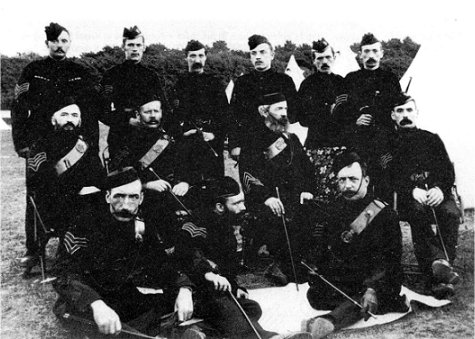
1st Volunteer Battalion Worcestershire
Regiment N.C.O.'s
First commissions dated 6th September, 1803.
The company was merged into the West Worcestershire Volunteer Battalion shortly afterwards.
Commissions dated 2nd May, 1798.
Volunteer Chart: 1808.
Bromsgrove Light Horse.
Number in Corps: 49.
Captain Jno. Adams.
Coat: Blue
Facings: Yellow
Breeches: White
Officers’ Lace: Gold.
2 Companies. Earliest commission 15th September. 1803. Had a Chaplain and a Surgeon.
Volunteer Chart: 1808.
Strength: 155
Captain: C. Norbury.
Coat: Scarlet.
Facings: Buff.
Breeches: White.
Officers’ lace: Silver.
Commissions dated 11th October, 1803.
Volunteer Chart: 1808.
Strength: 49.
Captain: Tho. Brettell.
Facings, etc.— not given.
Commissions dated 22nd November, 1803.
1805. “Loyal” omitted.
Volunteer Chart: 1808.
Strength: 232.
Lt.-Colonel: Hon. Jno. Wm. Ward.
Coat, etc., not given.
One weak company.
Earliest commissions dated 15th September, 1803.
Volunteer Chart: 1808.
Strength: 66.
Captain: S. T. Forrester.
Coat, etc., not given.
Earliest commissions dated 24th November, 1803.
1805 Changed to East Worcester.
1808. Loyal Evesham and Pershore Battalion of Volunteer Infantry (Colonel Jeffry Amherst), 440 strong, in September became East Worcestershire Local Militia.
Commissions dated 6th September, 1803.
Volunteer Chart: 1808.
Loyal Feckenham Infantry.
Strength: 124.
Captain: Robert B. Waldron.
Coat Scarlet.
Facings: Buff.
Breeches : White
Officers’ Lace : Silver.
Earliest commission dated 15th September, 1803. Company omitted in 1805 list.
Commissions dated 6th September, 1803.
Volunteer Chart: 1808.
Hanbury Light Infantry.
Strength: 123.
Captain: Jno Weir.
Coat : Scarlet.
Facings: Buff.
Breeches: White.
Officers lace: Gold.
Commissions dated 15th November, 1802.
Volunteer Chart 1808.
Strength: 55.
Captain: Sam Steward.
No other details.
Three Companies. Earliest commissions dated 6th September, 1803. In 1804 or 1805 was formed with 1 Company (Bewdley), 1 Company (Loyal Stourport) into West Worcestershire Volunteer Battalion. This and some detached Corps were merged into the West Worcestershire Local Militia under Lord Foley.
Commissions dated 27th September, 1803.
Volunteer Chart: 1808.
Strength: 47.
Captain: Henry Guest.
Coat: Scarlet.
Breeches: White.
Facings: Black.
Officers’ lace: Gold.
Commissions dated 6th September, 1803. Not in the 1805 list.
Commissions dated 12th August, 1803.
Volunteer Chart: 1808.
Loyal Shipston Infantry.
Strength: 132.
Captain: John B. Bellamy.
Coat: Scarlet.
Facings: Buff.
Breeches: White.
Officers’ lace: Silver.
Commissions dated 6th November, 1802.
Volunteer Chart: 1808.
Stourbridge Cavalry 1st Troop.
Strength : 52.
Captain: Jno. Adderbrooke.
Coat: Blue.
Facings: Black.
Breeches : White.
Officers’ lace : Gold.
Commissions dated 12th September, 1803.
Volunteer Chart: 1808.
Stourbridge Cavalry 2nd Troop.
Strength: 35.
Captain: Tho. Homfray.
Coat: Blue.
Facings: Black.
Breeches : White.
Officers’ lace : White.
Commissions dated 6th September, 1803. Omitted from 1805 List. See Kidderminster Infantry.
Commissions dated 6th September, 1803.
Volunteer Chart: 1808.
Strength: 114. -
Captain: Edward Wheeler.
Coat: Scarlet.
Facings: Buff.
Breeches: White.
Officers’ lace: None worn.
Commissions dated 27th September, 1803.
Volunteer Chart: 1808.
Strength: 40.
Captain: Jno. Knight.
No other details.
Earliest commission dated 2nd September, 17%.
Volunteer Chart: 1808.
Strength: 171.
Captain: Lt.-Col. Hon. J. S. Cocks.
No other details.
Earliest commissions dated 6th September, 1803.
1805. Title changed to “City of Worcester.”
Volunteer Chart: 1808.
Strength: 800.
Lt.-Col. Hon. C. W. Coventry.
Coat: Scarlet.
Facings: Buff.
Breeches: Blue.
Officers’ lace: Silver.
The Corps had eight companies, including one of Grenadiers.
Volunteer Chart: 1808.
Loyal East Worcestershire.
Strength: 458.
Lt.-Col. Jeffery Amherst.
Coat: Scarlet.
Facings: Buff.
Breeches: White.
Officers’ lace: Silver.
Commissions dated 15th September, 1803
Volunteer Chart: 1808.
Strength: 500.
Lt.-Col. Wm. Villiers.
Coat: Scarlet.
Facings: Buff.
Breeches: Buff.
Officers’ lace: Not worn.
Earliest commissions dated 18th August,
1803. Ten Companies.
Volunteer Chart: 1808.
Strength: 800.
Colonel: Thomas Bland (1803-08).
Coat: Scarlet.
Facings: Buff.
Breeches: White.
Officers’ lace: Silver.
Appears for first time in list for 1805.
Volunteer Chart: 1808.
Loyal West Worcestershire.
Strength: 474.
Lt.-Col. Fras. Johnson.
Coat: Scarlet.
Facings: Buff.
Breeches: White.
Officers’ lace: Gold.
One of the chief reasons for the establishment of the Local Militia was, as was well-known at the time, the feeling on the part of the authorities that no reliance could be placed on the Volunteer Force that was then in existence, and had been since the threatened invasion of 1803. Volunteering at that time, although in many cases very hearty and patriotic, was at best never anything else than playing at soldiering. The members of the various corps were only civilians in uniform.
At the same time, the Government did not avow openly that they intended the Local Militia to supersede the Volunteers, for so long as the number of Volunteers and Yeomanry in a County amounted to the quota fixed for the Local Militia, no ballot would be put into force; but as soon as any deficiency existed, the difference would be at once made up by establishing Local Militia. But they gave permission to existing Volunteer Corps to transfer their services in a body to the Local Militia, and they relied on the supposition that it would be largely taken advantage of, which turned out to be correct. The expense of their maintenance was beginning to fall heavily on the Volunteers themselves, and the Government intimated that the assistance that they had hitherto granted would be almost entirely withdrawn; in consequence, the Volunteers of almost every County transferred their services to the Local Militia, and regiments were formed strictly under the articles of war.
The services of the force were at first confined to the Counties in which they were raised, but by an Act of 1813 they were liable to serve out of their counties until 1815. In 1816 the ballot was suspended and the Local Militia allowed to die out.
10 Companies. H.Q. Worcester.
Establishment 700 men.
Lt.-Col. Commandant Fernando Smith.
Formed from Loyal Worcester Volunteers.
Rendered some service in 1811 during the Burdett Riots at
Worcester and Kidderminster.
Drawing of a colour in book at the R.U.S.I., Whitehall,.
Buff inscribed WORCESTER L.M. special design.
10 Companies. H.Q. Bromsgrove.
Establishment 700 men.
Lt.-Col. Commandant Richard Williams
Formed from North Worcester Volunteers.
10 Companies. H.Q. Evesham.
Establishment 600 men.
Colonel Commandant Jeffery Amherst.
Formed from Loyal East Worcestershire Volunteers.
Colour: Buff of usual pattern with title within wreath,.
E. WORCESTER L.M.
HQ. Worcester. 8 Companies.
Establishment 600 men
Lt.-Col. Commandant: Thomas Lord Foley.
Formed from West Worcestershire Volunteers
Piece of Drummer’s lace in a book at the Public Records Office,. W.O. 44607, is the same as that of the Worcestershire Militia..
10 Companies. H.Q. Upton-on-Severn..
Establishment 700 men.
Lt.-Col. Commandant: Hon. Wm. Beauchamp Lygon.
Formed from the South Worcester Volunteers.
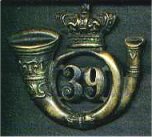
Officers' Cap Badge of the
Worcestershire Rifle Volunteers
(1859 - 1900)
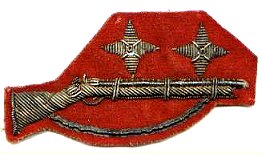
Worcestershire Rifle Volunteers
Sharp Shooters badge
After the Great War the Territorial Force, in recognition of its great services during the war, was made the Territorial Army and allowed to bear on its Colours the Battle Honours of their Regular Battalions.
During the period 1908 to 1920 the T.F. Battalions wore the same badge as the Regulars, but in white metal. Previous to this the badge of the Volunteers had been the Pear Tree of Worcester — the traditional badge of the Archers of Worcestershire at Crecy and Poitiers.
1st. Wolverley
2nd. Tenbury
3rd. Kidderminster
4th. Kidderminster
5th. Bewdley
6th. Halesowen
7th. Dudley
8th. Stourport
9th. Stourbridge
16th. Oldbury
20th. Kiddermjnster
10th. Pershore
11th. Great, Malvern
12th. Evesham
13th. Worcester
14th. Worcester
15th. Ombersley
17th. Redditch
18th. Droitwich
19th. Upton-on-Severn
21st. Bromsgrove
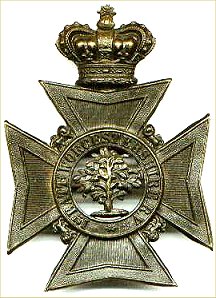
1st Worcestershire Rifle Volunteers
Helmet Plate (1880's)
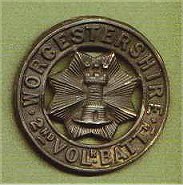
2nd Volunteer Battalion
Cap Badge (1881-1884)
Extract from History of the Forces. Manual of Military Law, 1929, chapter IX. para. 133.
“A Volunteer Force was raised during the Great War for Home Defence. From 1914 to 1916 a body termed Volunteer Training Corps was raised and administered privately with the recognition of the War Office, but in 1916 the War Office authorised the raising of Volunteer Units under the Act of 1863, and the existing Corps thereafter came under the control of the War Office. A new Act (6 & 7 Geo. V. c. 32) was passed in 1916, which gave effect to agreements on the part of members of the force to undergo military training or to perform military duties (or both), and rendered such members subject to Military Law. From May, 1918, men granted exemption certificates under the Military Service Acts were liable to serve in the Volunteer Force as a condition from compulsory service in the Army.
The force, which consisted of Artillery, Engineers, Infantry, Army Service Corps and Medical personnel, was disbanded at the end of the War. The Act of 1916 expired in 1921, but the Acts of 1863 and 1900 are still in force.”
Numerous Corps were formed all over the County as in 1859. Amongst others there were Corps at Halesowen, Kidderminster, Stourport, Worcester, Redditch, Dudley, Bewdley. The members of these Corps bought their own uniforms and rifles. In 1916 these were consolidated into the Worcestershjre Volunteer Regiment. This had three Battalions with H.Q. at Kidderminster, Worcester and Redditch respectively.
but the 3rd (Redditch) Battalion had Sir Herbert Austin.
By an Order in Council dated May 17th, 1940, the last of the Volunteer movements started.